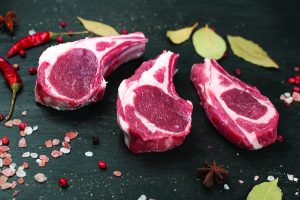THE KITCHEN DIVA: A love affair with lamb
By Angela Shelf Medearis — March 25, 2021
In Australia, where lamb is raised in abundance and eaten regularly, recent studies show it as the top omega-3 food in the daily diet. (Depositphotos)
I seldom prepared or served lamb until I tasted Australian lamb. The tenderness and variety of cuts of Australian lamb opens up the opportunity to serve lamb all year long, not just in the spring. I love slowly braising lamb shanks, marinading and flash-frying lamb chops, and using ground lamb in stews, sauces and forming them into patties.
Lamb is the meat from young sheep that are less than a year old. Americans eat far less of this delicious meat than people in other countries. It’s often a case of not knowing how to select the best cuts of lamb or misinformation about the meat having a strong “gamey” flavor.
Current labeling laws often allow a confusing number of packaging terms as it pertains to lamb, including “natural,” “pasture-raised” or “grass-fed.” These terms are allowed even though the animal may not spend any time in a natural setting, in a pasture or grazing on grass. The label to look for to purchase the best-quality lamb meat is either “100 percent grass-fed,” “organic-100 percent grass-fed lamb” or “100 percent grass-fed.” This type of lamb has a buttery, tender quality.
Australian lamb can be found in most American markets and is generally available in five different cuts: the shoulder, rack, shank/breast, loin and leg. “Rack of lamb” usually refers to a rib cut that includes nine ribs and can be split into rib roasts. Lamb “chops” can come from several different cuts.
For example, “rib chops” come from the rib, and “loin chops” come from the loin. You might also see “blade” and “arm” chops in the meat section of the grocery; these chops come from the shoulder. Sirloin chops come from the leg. Additionally, many stores sell lamb that has already been ground and can be used to make burgers, meat loaf or sauces.
100 percent grass-fed lamb is a significant source of B vitamins and niacin. It also is an excellent source of omega-3 fats, dependent upon the diet of the mother and the lamb. Grass-fed lamb has been shown to average at least 25 percent more omega-3 fats than conventionally fed lamb. Consumption of omega-3 fats has been associated with decreased risk of inflammation and heart disease.
In Australia, where lamb is raised in abundance and eaten regularly, recent studies show it as the top omega-3 food in the daily diet. In regions of some countries without easy access to fish, lamb has sometimes been shown to provide the most omega-3s of any other food in the diet.
This recipe for Australian-Style Lamb Sauce With Pasta provides an Aussie twist on a traditional Italian Bolognese-style sauce. For more information about Australian lamb or beef, and to select from a delicious variety of recipes, go to trueaussiebeefandlamb.com.
AUSTRIALIAN-STYLE LAMB SAUCE WITH PASTA
2 pounds Australian ground lamb
10 ounces dried macaroni
3 tablespoons olive oil
1 medium white onion, peeled and finely diced
2 cloves garlic, peeled and crushed
1 1/2 teaspoons salt
1 1/2 teaspoons ground black pepper
1 teaspoon ground cinnamon
1/2 teaspoon ground cloves
1/8 teaspoon crushed red peppers or cayenne pepper
2 bay leaves
1 cup chicken broth
1 (16-ounce) can chopped tomatoes
2 cups crumbled feta cheese or Parmesan cheese
- Cook the pasta according to packet directions. Add salt to the boiling water, cook until al dente and then drain.
- Heat olive oil in a large frying pan on medium heat. Add the onion, garlic, 1 teaspoon each salt and black pepper, cinnamon, cloves and red pepper or cayenne pepper. Saute for 2 to 3 minutes, without browning the garlic. Add the ground lamb, crushing any lumps with the back of a spoon. Cook until lamb is browned, stirring occasionally, about 5 to 6 minutes.
- Add the bay leaves and chicken broth. Reduce heat to a simmer, add tomatoes and stir to combine. Cook 25 minutes; stirring occasionally and season with the remaining 1/2 teaspoon of the salt and pepper.
- Remove and discard the bay leaves. Add the pasta to the pan and combine with the meat sauce. Sprinkle with the cheese, and serve immediately. Serves 4 to 6.
***
Angela Shelf Medearis is an award-winning children’s author, culinary historian and the author of seven cookbooks. Her new cookbook is “The Kitchen Diva’s Diabetic Cookbook.” Her website is www.divapro.com. To see how-to videos, recipes and much, much more, Like Angela Shelf Medearis, The Kitchen Diva! on Facebook. Recipes may not be reprinted without permission from Angela Shelf Medearis.
© 2021 King Features Synd., Inc., and Angela Shelf Medearis



